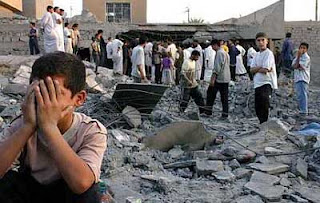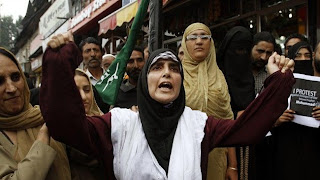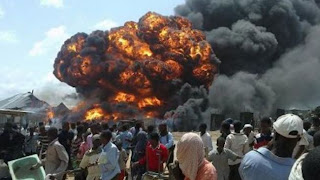 |
| U.S. drone launch |
UAVs must be unambiguously written into international
treaties; their makers, agents, governments and their leaders must adhere,
without exception, to international arms and related treaties, international
conventions, humanitarian and human rights laws
Excerpt from Medact report
Editing, minor comment by Carolyn Bennett
“Drones invade personal space and physically and chronically
restrict people’s normal life,” says this latest medical professionals’ report
on unmanned aerial vehicles. Evidence has shown that the presence of drones
contributes to the disruption of vital public health programs. A Taliban leader
in Waziristan reported that “polio vaccinations of children in that region will
be prevented as long as the as the United States continues to use drones to
kill targets there.”
 |
| Children and kin suffer |
The United States regularly bombs the tribal region where
the borders of Afghanistan and Pakistan join.
Civilians suffer most
he deaths and injuries suffered by innocent civilians who
happen to be in the vicinity of a drone’s target go largely unreported. These
men, women and children remain statistics: anonymous and nameless.
The psychological impact on civilians – including many
children – who live under the constant threat of drones, is unacceptable, and
is not taken into account by those who use them.
 |
| Women protest |
Evidence is also emerging of damage to the mental health of
those who operate UAVs. Watching a target on a computer screen for days,
tracking the target’s every move, then pressing a button that will kill
[people] and possibly [their] family or friends, can create ‘physical
exhaustion,’ ‘high operational stress’ and ‘clinical distress.’
omen are disproportionately affected by drones. What little
control they have over their lives is further eroded by a weapon they know
could strike at any time. Under constant threat, women try to protect their
lives and those of the children. “While men can sublimate their grief and anger
to some degree by becoming fighters – one of the terrible consequences of drone
warfare – women have no such outlet,” the report says. “And if their [male
partners] are killed in a drone strike, women may have to endure the continuing
presence of the drone just overhead.”
The degree to which drones contribute to the loss of human
dignity is made clear by a description of life in the Gaza Strip (Israel
together with the U.S. and UK are leading users of UAVs):
‘The
constant surveillance from the sky, collective punishment through blockade and
isolation, the intrusion into homes and communications, and restrictions on
those trying to travel, or marry, or work make it difficult to live a dignified
life in Gaza.’
 |
| Somalis under drone attack |
RONES: the physical and psychological implications of a
global theatre of war” is a report by Medact that describes the journey that
led to the proliferation of these weapons and the physical and psychological
damage they cause to civilians and to the military personnel who operate them.
The report also explores the moral and legal issues raised by the use of drones
in ‘legalized’ assassinations or ‘targeted killings.’”
Formed
in 1992 by a merger of two older organizations (the 1951 Medical Association
for the Prevention of War and the 1980 Medical Campaign Against Nuclear Weapons),
Medact is a global health charity that takes on issues at the center of
international policy debates.
Led
by its health professional membership, Medact undertakes education, research
and advocacy on the health implications of conflict, development and environmental
change. It focuses on war and weapons … complemented by action on the
health impacts of poverty and environmental change. http://www.medact.org/medact_information.php
 |
Drone destruction
Civilian trauma |
These are some of the critical issues discussed in Medact’s October
13, 2012, report on drones.
The health professionals who author this report say the
reasons for their concern about the increasing use of drones ─ in addition to
the number of deaths and injuries of innocent civilians ─ have to do with “the
psychological damage to people living under the constant threat of drone attack
and to service personnel who carry out the assassinations”; and growing evidence
that medical personnel and others who arrive at the scene of drone attacks to
assist the injured are also being targeted. “This is a war crime.”
The numbers of civilians killed by drones are only
estimates, the report says, the most accurate for Pakistan where estimates
range from “light casualties to estimates from the Bureau of Investigative
Journalism (BIJ) of large numbers of civilian deaths, including children,
family members attending funerals, people on rescue missions and medical
personnel.” The number of deaths resulting from drone strikes in Pakistan,
Yemen and Somalia as reported by BIJ is between 201 and 213 children killed
since 2001; and the total estimated
deaths between 2,985 and 4,533.
 |
| Drone destruction |
Questions of judgment, ethics and morality
“The use of unmanned weaponry necessarily has a corrupting
effect on those directing it because it implies that war is being waged only
against a few sinister individuals,” the authors write. Viewed in the context
of human behaviors that cultivate and regulate complex interactions within
social groups, the use of this weaponry violates any principle of morality
defined as a construct of interrelated other comprising the ability
to understand or empathize with your opponent. “All aerial warfare raises moral and ethical
issues,” they write, and the bombing of civilians raises moral issues for those
who direct the operations as well as for those who execute the attacks [the
authors do not include but should, in my view: the moral and ethical breach of
those who decide and who order these operations and executions].
“Drones,” they conclude, “could lead to a world of
globalised warfare, in which people may find themselves within a theatre of war
literally anywhere on the planet.”
Surely this can be characterized as enslavement, endless
torture: the ultimate inhumanity of human beings to other human beings.
 |
| United Nations |
Questions of law
Claims of legality and accuracy of these weapons are simply
untrue, this report suggests. In situations of actual armed conflict, the
Geneva Conventions and other rules of International Humanitarian Law (IHL)
apply. The Geneva Conventions developed in 1949 as a result of the Second World
War codified “general principles with clear implications for aerial bombardment
─ in particular the need for attacks to be proportional to their anticipated
military advantage, and to discriminate between combatants and civilians.”
The Obama government’s claim “that killing, using military
force outside of armed conflict zones, is lawful under international law,” the
authors report, is a “baseless” claim. “Indeed while theatre specific
conventions relating to war on land and at sea exist in international law, no
such conventions apply to aerial warfare.”
The claim that armed drones can be more accurate than other
weapons of aerial warfare at discriminating between combatants and civilians,
and are thus more likely to conform to IHL is also untrue. The report states:
Evidence
of accuracy is not always borne out in reality, and identifying ‘suspicious
behavior’ from aerial observation can lead to mistakes.
Moreover,
the fact that the U.S. drones program classifies as possible militants all
military aged men within the area of a drone strike greatly increases the risk
of civilian deaths, and the likelihood that attacks will be indiscriminate
under International Humanitarian Law.
International Human Rights Law (IHRL) also applies in a
country experiencing conflict but where conflict had not been officially
declared. A government can suspend some (but not all) of these rights if there
is a national emergency that could be caused by an ‘unofficial’ conflict.
A right “that cannot be suspended is the ‘right not
arbitrarily to be deprived of one’s life.’
“If attacks by armed drones were shown to be arbitrary, they
would then be considered illegal depending on the definition of ‘arbitrary.’
The International Court of Justice has ruled in one case that this should be
decided by the law applicable in situations of declared armed conflict (‘lex
specialis’),” thus returning to the argument of International Humanitarian Law
and its core principles of proportionality and discrimination.
laims that the military benefit justifies the risk of
civilian death and injury, that accuracy of drones increases their ability to
be more ‘proportional’ (civilians in proportion to “militants” or vice versa) is
a flawed argument as is the “imminent” attack argument.
Peoples of the Middle East and Africa who suffer the brunt
of U. S. aggression (from the ground, air or sea) never have been and never
will be an imminent threat or danger to the people or possessions of the United
States of America.
The authors use an example of moral justification claimed in
a decision to kill ten innocent civilians who happen to be in the same building
as the “target” because it is believed the “target” may be planning to kill 100
people in the future, which serves to encourage the use of assassination
drones. “Given that the majority of
these attacks are pre-emptive, that intelligence may be inaccurate, and
observation misleading” makes clear “the slippery slope [that] leads to the
death of civilians.
 |
facade
International Criminal Court |
“One purpose of law,” they point out, “is to determine
accountability:
Who is to blame when a mistake is
made and civilians are killed due to incorrect intelligence, possibly obtained
under duress or provided with alternative motives?
Who is to judge the likelihood –
and therefore proportionality – of that action when an attack is carried out in
anticipation of an action?
“These issues muddy the waters not only of the legal, but
also the moral and ethical situation.”
Background of an accelerating depravity, breakdown
n the past decade, proliferation of unmanned aerial vehicles
(UAVs) commonly known as ‘drones’ has skyrocketed.
Before the World Trade Center events of September 11, 2001,
the United States Air force began experimenting with armed drones. In 2001, a
Hellfire missile was successfully fired from a Predator drone at a stationary
target in the Nevada Desert and the same year a CIA-operated Predator drone was
used in combat for the first time to assassinate an alleged al-Qaeda leader, Mohammed
Atef, in Afghanistan.
In succeeding years, the United States has used drones in
Afghanistan, Pakistan, Yemen, Somalia, Libya and Iraq. Israel has reportedly
used armed drones in Gaza. The United Kingdom has used them in Afghanistan. Now,
more than seventy-five countries are thought to possess some type of drone.
 |
Children suffer most
as does the future |
Three countries (the United States, Britain, and Israel) are
known to have used armed drones in combat, the report says; but Singapore,
India, China and Russia have developed or purchased drones; and, in the coming
decade, the annual drone market (U.S. leading next eight years’ spending $32
billion, Asia Pacific nations following) is expected to rise from $5.9 billion
to $11.3 billion.
Plans are on the drawing board “for drones to become
increasingly automated, with the ability to fly pre-programmed missions and
eventually select their own targets,” the report says.
The
future may see solar-powered drones and drones that can take off vertically
from ships.
Blueprints
for the production of nuclear-powered
drones, capable of staying airborne for months at a time, were drawn up [but
then] shelved in anticipation of negative public opinion] by the U.S. government’s main R and D agency
Sandia National Laboratories.
The report’s list of countries involved in the export and
development of drones (taken from Drone Wars UK) include:
ISRAEL (Directly exported: Australia, Canada, Ecuador, Germany, India,
Mexico, Philippines, Singapore, South Korea, Spain, Sri Lanka, Thailand, Turkey;
Helped to develop: Finland, France, Switzerland, UK)
 |
| U.S. drone |
UNITED STATES (Directly exported: Belgium, Egypt, Italy, Morocco, Turkey,
UK;
Helped to develop: Germany)
FRANCE (Directly exported: Greece, Netherlands, Sweden)
SOUTH AFRICA (Directly exported: Sri Lanka)
onsidering drones from a public health perspective reveals:
the human cost of their use, the moral and ethical issues raised by ‘targeted
killings’ and their dubious legal status,” the authors conclude their report
with recommendations.
“Drone strikes are frequently based on an ‘imminent threat’
and potentially
inaccurate intelligence, in situations of highly asymmetric
conflict (violent conflict between a formal military and an informal,
poorly-equipped, but resilient opponent).
 “Far from defeating terrorism, drone attacks appear to act
as a recruiting agent ─ including for suicide missions.”
“Far from defeating terrorism, drone attacks appear to act
as a recruiting agent ─ including for suicide missions.”
The Medact report recommends greater parliamentary and
public scrutiny of the use of drones, the inclusion of these UAVs in arms reduction
treaties, and the end to further automation in their operations. As Medact is a
UK organization, the report calls on their government in particular to stop
purchasing, developing and deploying armed drones. Others in the United States,
including 2012 U.S. presidential candidate and physician Jill Stein (Green
Party), have made a similar call as well for a binding international treaty.
“We believe,” the
report concludes, “that it is in the public interest and in the interest of our
armed forces that there should be more transparency, parliamentary scrutiny,
and public debate on ─
How drone strikes are planned
How targets are chosen
Who is targeted and why
Sources and notes
“Drones: the physical and psychological implications of a
global theatre of war,” October 13, 2012,
http://www.medact.org/content/wmd_and_conflict/medact_drones_WEB.pdf
HOW DID WE GET HERE [Medact]
1910 U.S. air force experimental bombing
Sandbags over the sides of planes
1911 Ain Zara Libya
Hand dropped bomb
1914-18 World War 1
The aeroplane is the new battlefield weapon
1937 Spanish Civil War
Air raid on Guernica kills over 200 civilians
1944-45 World War II
‘Doddlebugs’ or V1s – a prototype UAV
Mid 1950 United States
V1 developed into surface to surface cruise missile – a
‘pilotless bomber’
1955-75 Vietnam War
Remotely Piloted Vehicles developed
1973 Yom Kippur War
Drones used to draw fire
1990-91 Gulf War
Unmanned Aerial Vehicles (UAVs) or drones used for
surveillance
1999 War in Kosovo
UAVs used for surveillance
2001 Conflict in Afghanistan
February: first test of an armed UAV.
November: first assassination using an armed UAV
2007 Conflict in Afghanistan
British forces start to use UAVs
2002-2012 Armed UAVs used for assassinations in Afghanistan,
Iraq, Libya, Pakistan, Somalia, and Yemen
2012 An estimated 76 countries have some sort of UAV
First British UAV base being set up at RAF Waddington
President Obama supervises a ‘kill list’ to decide which
individuals are targeted.
Beyond 2020 Prospect of rapid proliferation
Development of more autonomous UAVs including possible self
selection of targets
PRESS RELEASE: On October 13th Medact launched its report “Drones:
the physical and psychological implications of a global theatre of war,” http://www.medact.org/article_health.php?articleID=990
Drone report authors: Marion Birch – Director Medact; Gay
Lee – Nurse and Medact Board member; Tomasz Pierscionek – Academic Clinical
Fellow in Psychiatry and Medact Board member
Advisors: Chris Cole – Coordinator of Drone Wars UK and
Convenor, Drone Campaign Network; Professor Mary Ellen O’Connell – Robert and
Marion Short Chair in Law and Research
Professor of International Dispute Resolution, Kroc Institute, University of
Notre Dame; Dominick Jenkins – Independent Consultant; Miri Weingarten–
Physicians for Human Rights-Israel
Editor: Alison Whyte – Medact; Design: Sue MacDonald – SMD
Design
Published by Medact 2012 : The Grayston Centre, 28 Charles
Squre, London N1 6HT, United Kingdom; E info@medact.org; www.medact.org; Registered
charity 1081097 Company reg no 2267125; Medact is the UK affiliate of the
International Physicians for the Prevention of Nuclear War (IPPNW); © Medact
2012, Medact: http://www.medact.org/medact_information.php
Dr. Jill Stein, 2012 Green Party candidate for U.S.
presidency, has called for an international treaty on drones
Jill Stein and Gary Johnson Debate Transcript (by Alex
Gauthier) on 10/19/2012, IVN Online Debate, http://ivn.us/editors-blog/2012/10/19/jill-stein-and-gary-johnson-debate-transcript/?replytocom=1572
See also on drones: RootsAction, “an independent online
initiative dedicated to galvanizing Americans who are committed to economic
fairness, equal rights, civil liberties, environmental protection ─ and
defunding endless wars,” http://www.rootsaction.org/about-rootsaction
Asymmetric warfare
Asymmetric warfare describes what is also called ‘guerrilla
warfare,’ ‘insurgency,’ ‘terrorism,’ ‘counterinsurgency,’ and ‘counterterrorism,’
essentially violent conflict between a formal military and an informal,
poorly-equipped, but resilient opponent:
“war between belligerents whose relative military power differs
significantly, or whose strategy or tactics differ significantly”; struggles involving
strategies and tactics of unconventional warfare, the weaker combatants
attempting to use strategy to offset deficiencies in quantity or quality. http://en.wikipedia.org/wiki/Asymmetric_warfare
_______________________________________
Bennett's books are available in New York State independent bookstores: Lift Bridge Bookshop: www.liftbridgebooks.com [Brockport, NY]; Sundance Books: http://www.sundancebooks.com/main.html [Geneseo, NY]; Mood Makers Books: www.moodmakersbooks.com [City of Rochester, NY]; Dog Ears Bookstore and Literary Arts Center: www.enlightenthedog.org/ [Buffalo, NY]; Burlingham Books – ‘Your Local Chapter’: http://burlinghambooks.com/ [Perry, NY 14530]; The Bookworm: http://www.eabookworm.com/ [East Aurora, NY] • See also: World Pulse: Global Issues through the eyes of Women: http://www.worldpulse.com/ http://www.worldpulse.com/pulsewire
http://www.facebook.com/#!/bennetts2ndstudy
_______________________________________










 “Far from defeating terrorism, drone attacks appear to act
as a recruiting agent ─ including for suicide missions.”
“Far from defeating terrorism, drone attacks appear to act
as a recruiting agent ─ including for suicide missions.”
No comments:
Post a Comment